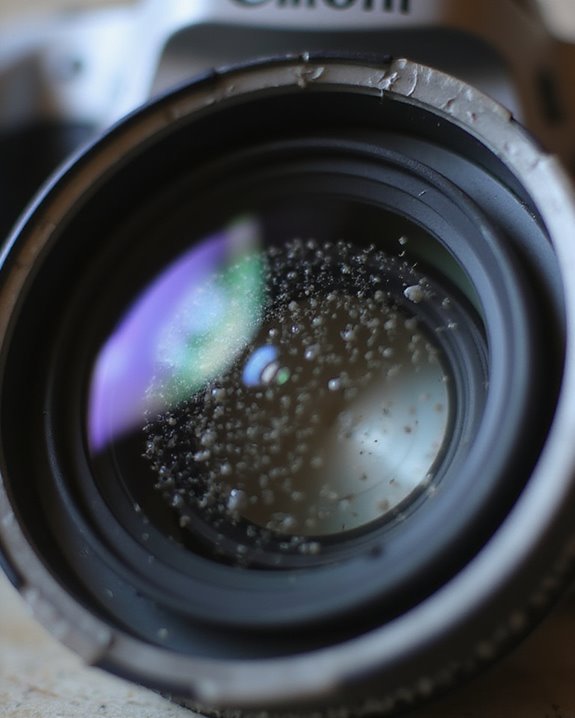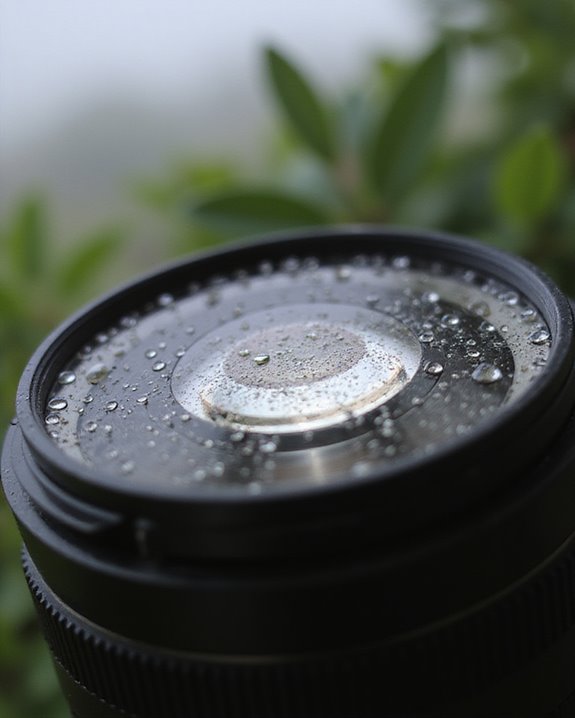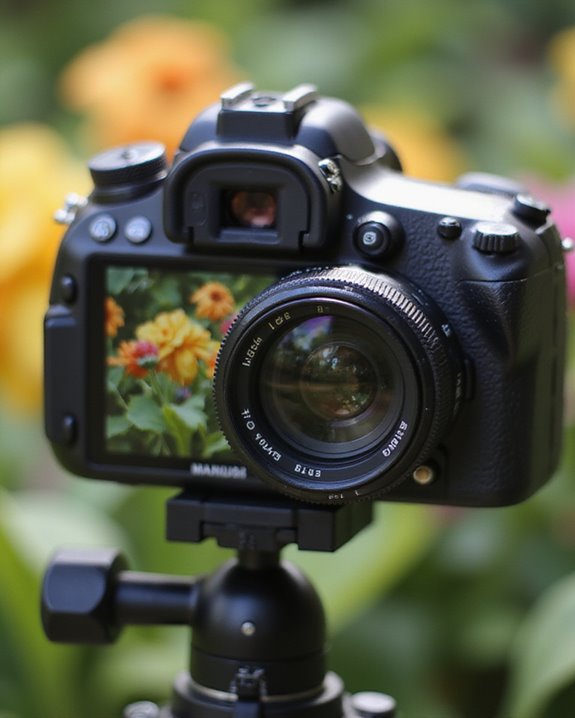Blurry camera lenses typically result from five common issues: camera movement, focus problems, inherent lens softness, environmental conditions, or dirty optics. We recommend first checking if your lens needs cleaning with a proper air blower and microfiber cloth technique. If cleanliness isn’t the issue, examine your autofocus settings, achieve adequate lighting, and use appropriate shutter speeds (minimum 1/focal length). Environmental factors like humidity and temperature changes can also compromise clarity. The following sections explore each potential cause with detailed solutions.
Key Takeaways
- Dirty lens surfaces with fingerprints or condensation significantly degrade image clarity and require proper cleaning with microfiber cloths.
- Camera movement during shooting, especially at slow shutter speeds below 1/125s, introduces blur that can be prevented with tripods.
- Autofocus malfunctions cause blurry images, requiring troubleshooting of compatibility issues, firmware updates, or professional calibration.
- Budget lenses or using extreme aperture settings can produce inherently soft images with reduced sharpness.
- Environmental factors like humidity and temperature changes cause lens condensation, resulting in foggy optics and unclear images.
Common Causes of Blurry Camera Lenses
The frustrating phenomenon of blurry camera lenses stems from numerous technical and environmental factors that photographers encounter regularly. We’ve found that camera movement represents a primary culprit, especially when shooting at slower shutter speeds where even slight vibrations, including mirror slap in DSLR cameras, can dramatically reduce image sharpness. Focus-related issues, such as malfunctioning autofocus systems or improper manual focus adjustments, frequently contribute to unsatisfactory results. Additionally, the inherent lens softness of certain optics, particularly budget-friendly models or lenses used at extreme apertures, can produce images lacking critical sharpness. Environmental conditions further complicate matters, as high ISO settings introduce noise that resembles blur, while inadequate lighting forces longer exposures prone to motion blur. Dirty lenses, fingerprints, or condensation also greatly degrade image clarity. Using proper lens cleaning techniques and lens maintenance can significantly improve overall image sharpness and prevent blurriness caused by surface contaminants.
How to Clean Your Camera Lens Properly

Properly cleaning your camera lens stands as one of the most effective solutions to the blurriness problems we’ve discussed, yet many photographers neglect this fundamental maintenance task until image quality noticeably deteriorates. We strongly recommend beginning with the Blower Technique, using a dedicated air blower to safely dislodge loose particles before any contact with the glass surface. Follow this essential first step with gentle brushing to remove remaining particulates, examining the lens under adequate light to verify all debris has been removed. When applying solutions, remember proper Microfiber Care—always dampen the cloth rather than the lens directly, using 1-2 drops of specialized lens fluid, then wipe in circular motions from center outward with minimal pressure. Avoid household cleaners or compressed air, as these can permanently damage the lens’s delicate anti-reflective coatings. Using a camera lens cleaning kit that includes microfiber cloths, cleaning solutions, and dust removal tools can make this process more effective and safer for your equipment.
Troubleshooting Autofocus Problems

Why does your perfectly clean lens still produce blurry images? Often, autofocus functionality is the culprit, rather than the lens itself. Check if your lens and camera body are properly matched, as incompatibility can prevent correct focusing. Low-light environments frequently challenge contrast detection systems, leading to hunting or complete failure to acquire focus.
Regular firmware updates are essential for best performance, as manufacturers continuously improve autofocus algorithms and fix known issues. If you’ve verified compatibility, tried appropriate AF modes, and updated firmware but still experience problems, a gear malfunction may be present. Signs include inconsistent performance, grinding noises during focusing, or complete AF failure. In such cases, professional calibration or repair service is necessary, particularly if internal components have become misaligned or damaged through impact or regular wear. Additionally, auto-focus calibration can sometimes resolve minor focusing inaccuracies without professional repair.
Environmental Factors Affecting Lens Clarity

Even when your autofocus system functions correctly, environmental conditions can dramatically impact the clarity of your images. Humidity presents one of the most significant challenges, as lens condensation occurs when cool glass surfaces meet warm, moisture-laden air, resulting in foggy optics. Weather patterns, including rain, snow, and fog, create additional obstacles by depositing water droplets or particulates directly onto your lens, affecting focal length and overall sharpness.
Seasonal variations influence image clarity through changing light conditions and temperature fluctuations. Summer’s high temperatures can increase sensor noise, while winter’s dramatic temperature shifts may cause rapid condensation when moving between environments. Additionally, dust particles, which are more prevalent during dry seasons, can accumulate on lens surfaces, degrading optical performance over time. Regular maintenance, including appropriate lens cleaning and the use of protective filters, becomes essential when shooting in challenging environmental conditions.
Technical Settings to Prevent Blurry Photos

The foundation of achieving tack-sharp photographs lies in mastering technical camera settings that work in harmony to eliminate blur. When configuring ISO Settings, we recommend keeping values as low as possible, particularly with smaller sensor cameras, as higher ISOs introduce noise that can manifest as apparent blurriness. For Shutter Techniques, faster speeds (typically 1/125s or above) help freeze motion, preventing subject-movement blur, while utilizing a tripod allows for slower speeds without compromising clarity.
Additionally, we’ve found that disabling image stabilization when using a tripod prevents contradictory compensation movements that can degrade sharpness. Selecting appropriate focus modes, such as continuous AF for moving subjects, guarantees your camera maintains critical focus throughout the capture process. For landscape photography, consider using mirror lock-up to eliminate internal vibrations that compromise sharpness.
Frequently Asked Questions
Can Lens Stabilization Technology Deteriorate Over Time?
Yes, we’ve found that stabilization technology does deteriorate. Stabilizer wear occurs naturally as mechanisms age, affecting tech longevity. Internal components can degrade, causing less effective shake reduction over time.
Does Using Third-Party Lenses Affect Autofocus Accuracy?
Yes, we’ve found third-party lenses can affect autofocus accuracy. They may have slower autofocus speed and varying lens compatibility with your camera body compared to native options, though quality varies between manufacturers.
How Do Lens Adapters Impact Image Sharpness?
While they’re often blamed unfairly, lens adapters can impact image sharpness. We’ve found that high Adapter Quality directly affects results—poor alignment and flange distance inconsistencies are key Sharpness Factors to evaluate when choosing adapters.
Can Firmware Updates Improve Lens Performance on Older Cameras?
Yes, we’ve found firmware updates can greatly improve lens performance on older cameras. They often enhance autofocus speed, stabilization, and compatibility, extending camera longevity by breathing new life into aging equipment.
Is Lens Calibration Necessary for Professional Photography?
We find lens calibration essential for pros despite calibration myths. Professional benefits include consistently sharper images and enhanced autofocus reliability—factors that distinguish amateur from professional work. It’s an investment in precision we can’t ignore.





